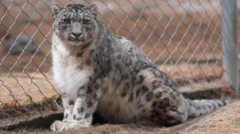A recent survey reveals that India's rivers are home to over 6,000 dolphins, but the Gangetic dolphins, along with their endangered Indus relatives, are under serious threat from fishing practices, habitat disruption, and increased vessel traffic.
Surviving Against the Tide: The Plight of India's River Dolphins

Surviving Against the Tide: The Plight of India's River Dolphins
Despite conservation efforts, India’s river dolphins face increasing threats in their natural habitats.
India is home to approximately 6,327 river dolphins, with the majority being the distinctive Gangetic dolphins, found primarily in the Ganges-Brahmaputra river system. Sadly, their survival is increasingly jeopardized. Unlike the marine dolphins we often see leaping gracefully in ocean waters, Gangetic dolphins display unique adaptations for river life. They are primarily blind, have longer snouts, and swim in a sideways position, maneuvering in the murky depths of their freshwater habitats.
A comprehensive survey conducted by the Wildlife Institute of India across 58 rivers and 10 states between 2021 and 2023 highlights the alarming state of these populations, classified as "endangered" by the International Union for Conservation of Nature (IUCN). Out of the total count, only three Indus dolphins were reported, with the majority located in Pakistan as the river flows through both nations.
The evolutionary history of river dolphins is remarkable; believed to have descended from marine ancestors millions of years ago, they adapted to freshwater conditions over time, becoming increasingly specialized. Unfortunately, these adaptations make them particularly vulnerable to human activities. Since the 1980s, more than 500 dolphins have perished due to fishing nets or deliberate killings, emphasizing the critical risk they face.
Efforts like the declaration of the Gangetic dolphin as India’s national aquatic animal in 2009, along with conservation initiatives such as a designated action plan and a research center established in 2024, have positively impacted their numbers, according to conservationist Ravindra Kumar Sinha. However, challenges persist. Dolphins continue to be poached for their meat and fat, utilized as fishing bait, while many fishermen hesitate to report accidental dolphin deaths due to fear of legal repercussions under stringent wildlife laws.
Furthermore, the burgeoning river cruise tourism industry poses a significant threat to dolphin habitats. Increased vessel traffic disrupts their tranquil environments, raising concerns regarding the impact of noise pollution, which can repel these sensitive animals.
River dolphins’ reliance on echolocation, stemming from their near blindness, is a double-edged sword; while effective for navigating murky waters, it exposes them to modern risks associated with pollution and vessel interactions. Their slow reproductive rate—a female gives birth to just one calf every two to three years—aggravates their vulnerable status.
While these challenges present a bleak outlook, Sinha remains optimistic, attributing improvements to government-led conservation initiatives. He stresses that while progress has been made, urgent efforts are still necessary to ensure these unique creatures thrive alongside their changing environments.






















